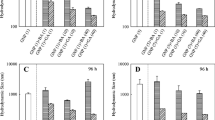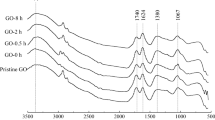Abstract
Graphene-family nanomaterials (GFNs) exhibit universal applications and consequently will inevitably enter aquatic systems. However, both the fate and behavior of GFNs in aquatic environments have not been completely explored at field relevant conditions. Herein, we have systematically investigated the aqueous aggregation and stability of graphene nanoplatelets (GNPs), graphene oxide (GO), and reduced graphene oxide (RGO) under varied solution chemistry parameters (pH, divalent cations, and dissolved organic carbon (DOC)) during 21 days of incubation in simulated natural environmental conditions. Results indicate that pH values from 6 to 9 had a notable impact on the aqueous behaviors of the three GFNs. Divalent cations (Ca2+ and Mg2+) at the concentrations of 2.5 and 10 mM remarkably increased the extent of aggregation of the three GFNs and resulted in severe sedimentation, independently of surface chemical functionalization. The presence of only DOC ranging from 0.5 to 2 mg C/L significantly elevated the dispersion stability of GNPs and RGO in a dose-dependent manner, whereas no effects were observed on GO. Furthermore, DOC at the studied concentrations and surface functionality were insufficient to counterbalance the impact of the divalent cations. Direct visual and in situ observations further supported the conclusions on the effects of divalent cations or/and DOC. These findings further underline that the environmental behaviors of GFNs are controlled by the complex interplay between water chemistry parameters and GFN surface properties.







Similar content being viewed by others
References
Chae SR, Xiao Y, Lin S, Noeiaghaei T, Kim JO, Wiesner MR (2012) Effects of humic acid and electrolytes on photocatalytic reactivity and transport of carbon nanoparticle aggregates in water. Water Res 46(13):4053–4062. https://doi.org/10.1016/j.watres.2012.05.018
Chen KL, Elimelech M (2007) Influence of humic acid on the aggregation kinetics of fullerene (C60) nanoparticles in monovalent and divalent electrolyte solutions. J Colloid Interface Sci 309(1):126–134. https://doi.org/10.1016/j.jcis.2007.01.074
Chen Y, Ren C, Ouyang S, Hu X, Zhou Q (2015) Mitigation in multiple effects of graphene oxide toxicity in zebrafish embryogenesis driven by humic acid. Environ Sci Technol 49(16):10147–10154. https://doi.org/10.1021/acs.est.5b02220
Chowdhury I, Duch MC, Mansukhani ND, Hersam MC, Bouchard D (2013) Colloidal properties and stability of graphene oxide nanomaterials in the aquatic environment. Environ Sci Technol 47(12):6288–6296. https://doi.org/10.1021/es400483k
Chowdhury I, Mansukhani ND, Guiney LM, Hersam MC, Bouchard D (2015) Aggregation and stability of reduced graphene oxide: complex roles of divalent cations, pH, and natural organic matter. Environ Sci Technol 49(18):10886–10893. https://doi.org/10.1021/acs.est.5b01866
Compton OC, Nguyen ST (2010) Graphene oxide, highly reduced graphene oxide, and graphene: versatile building blocks for carbon-based materials. Small 6(6):711–723. https://doi.org/10.1002/smll.200901934
Cosgrove T (2005) Colloid science: principles, methods and applications. Blackwell, Publishing Ltd. https://doi.org/10.1002/9781444305395
Domingos RF, Tufenkji N, Wilkinson KJ (2009) Aggregation of titanium dioxide nanoparticles: role of a fulvic acid. Environ Sci Technol 43:1282–1286
Dreyer DR, Park S, Bielawski CW, Ruoff RS (2010) The chemistry of graphene oxide. Chem Soc Rev 39(1):228–240. https://doi.org/10.1039/B917103G
Feng Y, Lu K, Mao L, Guo X, Gao S, Petersen EJ (2015) Degradation of 14C-labeled few layer graphene via Fenton reaction: reaction rates, characterization of reaction products, and potential ecological effects. Water Res 84:49–57. https://doi.org/10.1016/j.watres.2015.07.016
Garacci M, Barret M, Mouchet F, Sarrieu C, Lonchambon P, Flahaut E, Gauthier L, Silvestre J, Pinelli E (2017) Few layer graphene sticking by biofilm of freshwater diatom Nitzschia palea as a mitigation to its ecotoxicity. Carbon 113:139–150
Goldberg E, McNew C, Scheringer M, Bucheli TD, Nelson P, Hungerbühler K (2017) What factors determine the retention behavior of engineered nanomaterials in saturated porous media? Environ Sci Technol 51(5):2729–2737. https://doi.org/10.1021/acs.est.6b05217
Hu X, Zhou Q (2013) Health and ecosystem risks of graphene. Chem Rev 113(5):3815–3835. https://doi.org/10.1021/cr300045n
Hu L, Zeng G, Chen G, Dong H, Liu Y, Wan J, Chen A, Guo Z, Yan M, Wu H, Yu Z (2016a) Treatment of landfill leachate using immobilized Phanerochaete chrysosporium loaded with nitrogen-doped TiO2 nanoparticles. J Hazard Mater 301:106–118. https://doi.org/10.1016/j.jhazmat.2015.08.060
Hu L, Zhang C, Zeng G, Chen G, Wan J, Guo Z, Wu H, Yu Z, Zhou Y, Liu J (2016b) Metal-based quantum dots: synthesis, surface modification, transport and fate in aquatic environments and toxicity to microorganisms. RSC Adv 6(82):78595–78610. https://doi.org/10.1039/C6RA13016J
Hu L, Wan J, Zeng G, Chen A, Chen G, Huang Z, He K, Cheng M, Zhou C, Xiong W, Lai C, Xu P (2017) Comprehensive evaluation of the cytotoxicity of CdSe/ZnS quantum dots in Phanerochaete chrysosporium by cellular uptake and oxidative stress. Environ Sci: Nano 4:2018–2029
Hua Z, Tang Z, Bai X, Zhang J, Yu L, Cheng H (2015) Aggregation and resuspension of graphene oxide in simulated natural surface aquatic environments. Environ Pollut 205:161–169. https://doi.org/10.1016/j.envpol.2015.05.039
Hyung H, Kim JH (2008) Natural organic matter (NOM) adsorption to multi-walled carbon nanotubes: effect of NOM characteristics and water quality parameters. Environ Sci Technol 42(12):4416–4421. https://doi.org/10.1021/es702916h
Jeong SH, Kim KK, Jeong SJ, An KH, Lee SH, Lee YH (2007) Optical absorption spectroscopy for determining carbon nanotube concentration in solution. Synth Met 157(13-15):570–574. https://doi.org/10.1016/j.synthmet.2007.06.012
Jiang Y, Raliya R, Fortner JD, Biswas P (2016) Graphene oxides in water: correlating morphology and surface chemistry with aggregation behavior. Environ Sci Technol 50(13):6964–6973. https://doi.org/10.1021/acs.est.6b00810
Li Q, Xie B, Hwang YS, Xu Y (2009) Kinetics of C60 fullerene dispersion in water enhanced by natural organic matter and sunlight. Environ Sci Technol 43(10):3574–3579. https://doi.org/10.1021/es803603x
Li X, Chen W, Zhang C, Li Y, Wang F, Chen W (2016) Enhanced dehydrochlorination of 1,1,2,2-tetrachloroethane by graphene-based nanomaterials. Environ Pollut 214:341–348. https://doi.org/10.1016/j.envpol.2016.04.035
Loh KP, Bao Q, Ang PK, Yang J (2010) The chemistry of graphene. J Mater Chem 20(12):2277–2289. https://doi.org/10.1039/b920539j
Novoselov KS, Fal'ko VI, Colombo L, Gellert PR, Schwab MG, Kim K (2012) A roadmap for graphene. Nature 490(7419):192–200. https://doi.org/10.1038/nature11458
Ottofuelling S, Von Der Kammer F, Hofmann T (2011) Commercial titanium dioxide nanoparticles in both natural and synthetic water: comprehensive multidimensional testing and prediction of aggregation behavior. Environ Sci Technol 45:10045–10052
Petosa AR, Jaisi DP, Quevedo IR, Elimelech M, Tufenkji N (2010) Aggregation and deposition of engineered nanomaterials in aquatic environments: role of physicochemical interactions. Environ Sci Technol 44(17):6532–6549. https://doi.org/10.1021/es100598h
Sanchís J, Olmos M, Vincent P, Farré M, Barceló D (2016) New insights on the influence of organic co-contaminants on the aquatic toxicology of carbon nanomaterials. Environ Sci Technol 50:961–969
Shih C-J, Lin S, Sharma R, Strano MS, Blankschtein D (2012) Understanding the pH-dependent behavior of graphene oxide aqueous solutions: a comparative experimental and molecular dynamics simulation study. Langmuir 289:235–241
Su Y, Gao B, Mao L (2017a) Concurrent agglomeration and straining govern the transport of 14C-labeled few-layer graphene in saturated porous media. Water Res 115:84–93. https://doi.org/10.1016/j.watres.2017.02.052
Su Y, Yang G, Lu K, Petersen EJ, Mao L (2017b) Colloidal properties and stability of aqueous suspensions of few-layer graphene: importance of graphene concentration. Environ Pollut 220(Pt A):469–477. https://doi.org/10.1016/j.envpol.2016.09.089
Tang H, Zhao Y, Yang X, Liu D, Shao P, Zhu Z, Shan S, Cui F, Xing B (2017) New insight into the aggregation of graphene oxide using molecular dynamics simulations and extended Derjaguin-Landau-Verwey-Overbeek theory. Environ Sci Technol 51:9674–9682
Wan J, Zhang C, Zeng G, Huang D, Hu L, Huang C, Wu H, Wang L (2016) Synthesis and evaluation of a new class of stabilized nano-chlorapatite for Pb immobilization in sediment. J Hazard Mater 320:278–288. https://doi.org/10.1016/j.jhazmat.2016.08.038
Wan J, Zeng G, Huang D, Hu L, Xu P, Huang C, Deng R, Xue W, Lai C, Zhou C, Zheng K, Ren X, Gong X (2018) Rhamnolipid stabilized nano-chlorapatite: synthesis and enhancement effect on Pb- and Cd-immobilization in polluted sediment. J Hazard Mater 343:332–339. https://doi.org/10.1016/j.jhazmat.2017.09.053
Wang H, Hu YH (2013) Electrolyte-induced precipitation of graphene oxide in its aqueous solution. J Colloid Interf Sci 391:21–27. https://doi.org/10.1016/j.jcis.2012.09.056
Wang J, Chen Z, Chen B (2014) Adsorption of polycyclic aromatic hydrocarbons by graphene and graphene oxide nanosheets. Environ Sci Technol 48:4817–4825
Wang Z, Gao Y, Wang S, Fang H, Xu D, Zhang F (2016) Impacts of low-molecular-weight organic acids on aquatic behavior of graphene nanoplatelets and their induced algal toxicity and antioxidant capacity. Environ Sci Pollut R 23(11):10938–10945. https://doi.org/10.1007/s11356-016-6290-4
Wang Z, Zhang F, Wang S, Peijnenburg WJ (2017) Assessment and prediction of joint algal toxicity of binary mixtures of graphene and ionic liquids. Chemosphere 185:681–689. https://doi.org/10.1016/j.chemosphere.2017.07.035
Wu L, Liu L, Gao B, Muñoz-Carpena R, Zhang M, Chen H, Zhou Z, Wang H (2013) Aggregation kinetics of graphene oxides in aqueous solutions: experiments, mechanisms, and modeling. Langmuir 29(49):15174–15181. https://doi.org/10.1021/la404134x
Xia T, Fortner JD, Zhu D, Qi Z, Chen W (2015) Transport of sulfide-reduced graphene oxide in saturated quartz sand: cation-dependent retention mechanisms. Environ Sci Technol 49(19):11468–11475. https://doi.org/10.1021/acs.est.5b02349
Xiao Y, Vijver MG, Peijnenburg WJ (2017) Impact of water chemistry on the behavior and fate of copper nanoparticles. Environ Pollut 234:684–691. https://doi.org/10.1016/j.envpol.2017.12.015
Xiao Y, Peijnenburg WJ, Chen G, Vijver MG (2018) Impact of water chemistry on the particle-specific toxicity of copper nanoparticles to Daphnia magna. Sci Total Environ 610-611:1329–1335. https://doi.org/10.1016/j.scitotenv.2017.08.188
Zeng G, Wan J, Huang D, Hu L, Huang C, Cheng M, Xue W, Gong X, Wang R, Jiang D (2017) Precipitation, adsorption and rhizosphere effect: the mechanisms for phosphate-induced Pb immobilization in soils—a review. J Hazard Mater 339:354–367. https://doi.org/10.1016/j.jhazmat.2017.05.038
Zhao J, Wang Z, White JC, Xing B (2014) Graphene in the aquatic environment: adsorption, dispersion, toxicity and transformation. Environ Sci Technol 48(17):9995–10009. https://doi.org/10.1021/es5022679
Acknowledgements
Funding for this work was supported by the National Natural Science Foundation of China (21407080 and 41601519) and the Natural Science Foundation of Jiangsu Province (BK20150891 and BK20140987). We also thank the anonymous reviewers for helping to improve the manuscript.
Author information
Authors and Affiliations
Corresponding authors
Additional information
Responsible editor: Thomas D. Bucheli
Electronic supplementary material
ESM 1
(DOC 2351 kb)
Rights and permissions
About this article
Cite this article
Ye, N., Wang, Z., Wang, S. et al. Aqueous aggregation and stability of graphene nanoplatelets, graphene oxide, and reduced graphene oxide in simulated natural environmental conditions: complex roles of surface and solution chemistry. Environ Sci Pollut Res 25, 10956–10965 (2018). https://doi.org/10.1007/s11356-018-1326-6
Received:
Accepted:
Published:
Issue Date:
DOI: https://doi.org/10.1007/s11356-018-1326-6




